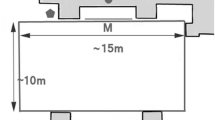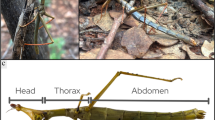Abstract
In this study we investigate associative learning related to food location in Vespula germanica social wasps. Wasps were trained to associate a certain location with food, and their behaviour after food displacement was recorded. The effect of a different number of previous feeding experiences on the detection of the novel food source was evaluated. When these wasps associated a certain location with food, they returned to the original site despite the fact that food was no longer available. This occurred even when a new food source was placed very close to the learned location. The results demonstrate that this learning seems to temporarily impair the detection of new food sources. We discuss how previous experience seems to condition perception, delaying the detection of more rewarding contexts.




Similar content being viewed by others
References
Akre RD (1982) Social wasps. In: Hermann HR (ed) Social insects. Academic, New York, pp 1–105
Archer ME (1998) The world distribution of the Euro- Asian species of Paravespula (Hym., Vespinae). Entomol Mon Mag 134:279–284
Cheng K (2005) Context cues eliminate retroactive interference effects in honeybees Apis mellifera. J Exp Biol 208:1019–1024
Cheng K, Wignall AE (2006) Honeybees (Apis mellifera) holding on to memories: response competition causes retroactive interference effects. Anim Cogn 9:141–150
Collett TS, Zeil J (1996) Flights of learning. Curr Dir Psychol Sci 5:149–155
D’Adamo P, Lozada M (2003) The importance of location and visual cues during foraging in Vespula germanica wasps. N Z J Zool 30:171–174
D’Adamo P, Lozada M (2007a) Foraging behaviour related to habitat characteristics in the invasive wasp Vespula germanica. Insect Sci 14:383–388
D’Adamo P, Lozada M (2007b) Foraging behaviour in Vespula germanica wasps when re-locating a food source. N Z J Zool 35:9–17
D’Adamo P, Lozada M (2008) Foraging behavior in Vespula germanica wasps when re-locating a food source. N Z J Zool 35:9–17
D’Adamo P, Lozada M (2009) Flexible foraging behavior in the invasive social wasp Vespula germanica (Hymenoptera: Vespidae). Ann Entomol Soc Am 102(6):1109–1115
D’Adamo P, Sackman P, Rabinovich M, Corley JC (2002) The potential distribution of German wasps (Vespula germanica) in Argentina. N Z J Zool 29:79–85
Farji-Brener A, Corley JC (1998) Successful invasions of hymenopteran insects into NW Patagonia. Ecol Austral 8:237–249
Gallistel CR, Fairhurst S, Balsam P (2004) The learning curve: implications of a quantitative analysis. PNAS 101(36):13124–13131
Giurfa M (2007) Behavioral and neural analysis of associative learning in the honeybee: a taste from the magic well. J Comp Physiol A 193:801–824
Hall G (1994) Pavlovian conditioning: laws of association. In: Mackintosh NJ (ed) Animal learning and cognition. Academic, San Diego, pp 15–43
Lozada M, D’Adamo P (2006) How long do Vespula germanica wasps search for a food source that is no longer available? J Insect Behav 19(5):591–600
Lozada M, D’Adamo P (2009) How does an invasive social wasp deal with changing contextual cues while foraging? Environ Entomol 38(3):803–808
Menzel R (2009) Learning and memory in invertebrates: honey bee. In: Squire LR (ed) Encyclopedia of neuroscience, vol 5. Academic, Oxford, pp 435–439
Moreyra S, D’Adamo P, Lozada M (2006) Odour and visual cues utilized by German yellow-jackets (Vespula germanica) while re-locating protein or carbohydrate resources. Aust J Zool 54:393–397
Raveret-Richter M (2000) Social wasp (Hymenoptera: Vespidae) foraging behaviour. Annu Rev Entomol 45:121–150
Raveret Richter MA, Jeanne RL (1985) Predatory behaviour of Polybia sericea (Olivier), a tropical social wasp (Hymenoptera: Vespidae). Behav Ecol Sociobiol 16:165–170
Sakai AK, Allendorf FW, Holt JS, Lodge DM, Molofsky J, With KA, Baughman S, Cabin RJ, Cohen JE, Ellstrand NC (2001) The population biology of invasive species. Annu Rev Ecol Syst 32:305–332
Takagi M, Hirose Y, Yamasaki M (1980) Prey-location learning in Polistes jadwigae Dalla Torre (Hymenoptera: Vespidae), field experiments on orientation. Kontyu 48(1):53–58
Zeil J, Kelber A, Voss R (1996) Structure and function of learning flights in bees and wasps. J Exp Biol 199:245–252
Acknowledgements
We are very grateful to Audrey Shaw for the revision of the manuscript. This study was partially funded through a grant from CONICET (PIP Nº 114200080100207). We also acknowledge support from the CRUB, Universidad Nacional del Comahue.
Author information
Authors and Affiliations
Corresponding author
Rights and permissions
About this article
Cite this article
Lozada, M., D’Adamo, P. Past Experience: a Help or a Hindrance to Vespula germanica Foragers?. J Insect Behav 24, 159–166 (2011). https://doi.org/10.1007/s10905-010-9244-6
Revised:
Accepted:
Published:
Issue Date:
DOI: https://doi.org/10.1007/s10905-010-9244-6




